 Here is a book that either changed people’s lives or irritated them. Count me among the latter.
Here is a book that either changed people’s lives or irritated them. Count me among the latter.
Eat Pray Love – One Woman’s Search for Everything Across Italy, India and Indonesia by Elizabeth Gilbert was supposed to enlighten me. It didn’t.
OK – First the positive: Overall, it is a well-written book. The author takes many complicated metaphysical concepts and makes them readable. The book is divided into sections: Eat, which is the author’s journey to Italy; Pray, her pilgrimage to India and Love, where she takes a lover in Bali.
This is about a thirty-something woman looking for spirituality and happiness. She is married, but desperately unhappy for no single reason that she cannot or will not divulge. So, she leaves her husband (and, by the way, gives him all marital property out of supposed “guilt” for leaving him, making me wonder what exactly she did to warrant this)and falls right into another relationship (a-ha! adultery, perhaps?). When the rebound relationship that broke up her marriage falls apart, she now wants to find God. Of course. She claims God spoke to her on the bathroom floor, thus beginning her journey.
But not before she goes to her publisher and secures a $200,000 advance for this book. Makes you wonder, as one reviewer on Amazon pointed out, was the journey retrofitted to the book proposal?
What better way to go find God than in Italy. For four months she eats gelato, practices her Italian with a young man named Luca Spaghetti (If you are going to make up names of allegedly real people, could you find a more sterotypical name? Why not Carmine OrganGrinder?) and gains 23 pounds — quick to point out to the readers that she was way underweight to beign with.
She learns to enjoy life and be selfish from the Italians – who by
the way still find her immensely attractive, although they don’t hoot and holler at her like they did 10 years previously. But she is still so damned cute. Just ask her.
On to India. At the Ashram, she learns to meditate and still broods over her lost marriage and subsequent realtionship. Probably the most boring part of the book, except for her conversations with “Richard from Texas” — a down home, larger than life character who speaks in folksy platitudes that would make Andy Griffith proud. He also bestows our author with her nickname “Groceries” because she was emaciated from grief from crying for the millionth time over her beloved David. As one reviewer from Amazon said, “What kind of nickname is Groceries?”
I honestly believe she made these people up. Reminds me of “Go Ask Alice” — supposedly the real story of the drug-addicted Anonymous — until it
was revealed that the protagonist was a fictitious composite of the author’s psychiatric patients. Boo.
Then Bali. She ends her self-imposed celibacy with an older Brazilian man. High on orgasmic ecstasy, out of the supposed goodness of her heart, she asks her
friends to send $18K in donations to help a single mother, an alleged friend of Ms. Gilbert’s, who is portrayed as a con artist because she didn’t buy a house in the timeframe coinciding with the termination of Ms. Gilbert’s visa. I always thought that a gift should be a gift without strings attached — especially coming from someone who supposedly found God. I wanted to ask Ms. Gilbert “What Would Jesus Do?”
My biggest problem with this tome is that this 30-something woman basically is looking for applause for running off for a year, obstensibly supported by a $200K book advance, to “find God.” I’m sure millions of women would love to leave their everyday lives and travel the world to do nothing but self analyze. If she had done volunteer work, I may have felt differently. If she went through some real hardship, I could sympathize. But she was in an incompatible marriage, then dumped by the guy she left her husband for. She should perhaps speak to those battling life-threatening diseases, or raising children alone, or taking care of an elderly parent, or worried about where their next meal is coming from.
And for all of her self-realization and navel-gazing to end her dependence on men, Ms Gilbert has, as pointed out by anotherAmazon reviewer, married her Brazilian and moved to new Jersey. She could have saved Penguin Books a whole lot of money by getting in her car and going through the Lincoln Tunnel. I wonder how long before she ends up back on the bathroom floor.
Love this product, take the stronger one if you have erectile dysfunction.
Generic levitra australia? Since we opened our doors in 2004, our shop has filled over 5 million discount prescription orders through our Canadian pharmacy.
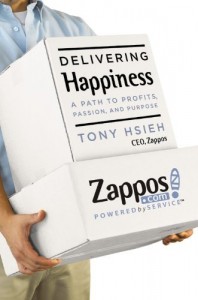 This book traces Tony Hsieh’s rapid progress in the business world, from callow party dweeb with a high IQ to his selling of Zappos to Amazon for north of a billion dollars. Along the way, we get some ups and downs in business start-ups, the hunt for money, the hunt for the secret to corporate long-term success, and some input from partners and employees along the way. Zappos’ leadership eventually decided to emphasize sterling customer service as the key to their own corporate culture, and the last third of the book – the part worth reading – covers what this means to the customer, to the employees tasked with turning it into a reality, and to the bottom line. The idea was to infuse ten larger values (with numerous sub-meanings and applications) into every aspect of every department of the company. Since Hsieh is now a billionaire or very close to it, one can say that, certainly in this case, it worked.
This book traces Tony Hsieh’s rapid progress in the business world, from callow party dweeb with a high IQ to his selling of Zappos to Amazon for north of a billion dollars. Along the way, we get some ups and downs in business start-ups, the hunt for money, the hunt for the secret to corporate long-term success, and some input from partners and employees along the way. Zappos’ leadership eventually decided to emphasize sterling customer service as the key to their own corporate culture, and the last third of the book – the part worth reading – covers what this means to the customer, to the employees tasked with turning it into a reality, and to the bottom line. The idea was to infuse ten larger values (with numerous sub-meanings and applications) into every aspect of every department of the company. Since Hsieh is now a billionaire or very close to it, one can say that, certainly in this case, it worked.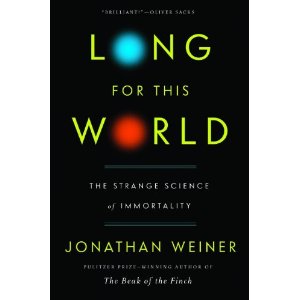 I have to say from the start that I am disappointed in this book. I was hoping for a detailed
I have to say from the start that I am disappointed in this book. I was hoping for a detailed 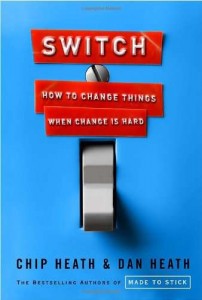 I am a big fan of the Heath brothers’ first book Made to Stick: Why Some Ideas Survive and Others Die and I am happy to report that they
I am a big fan of the Heath brothers’ first book Made to Stick: Why Some Ideas Survive and Others Die and I am happy to report that they  Here is a book that either changed people’s lives or irritated them. Count me among the latter.
Here is a book that either changed people’s lives or irritated them. Count me among the latter.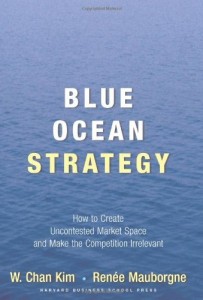 This is an especially thought-provoking book which, as have so many others, evolved from an article published in the Harvard Business Review. According to Kim and Mauborgne, “Blue ocean strategy challenges companies to break out of the red ocean of bloody competition by creating uncontested market space that makes the competition irrelevant…This book not only challenges companies but also shows them how to achieve this. We first introduce a set of analytical tools and frameworks that show you how to systematically act on this challenge, and, second, we elaborate the principles that define and separate blue ocean strategy from competition-based strategic thought.” There are six principles which are introduced and then discussed on pages 49, 82, 102, 117, 143, and 172, respectively.
This is an especially thought-provoking book which, as have so many others, evolved from an article published in the Harvard Business Review. According to Kim and Mauborgne, “Blue ocean strategy challenges companies to break out of the red ocean of bloody competition by creating uncontested market space that makes the competition irrelevant…This book not only challenges companies but also shows them how to achieve this. We first introduce a set of analytical tools and frameworks that show you how to systematically act on this challenge, and, second, we elaborate the principles that define and separate blue ocean strategy from competition-based strategic thought.” There are six principles which are introduced and then discussed on pages 49, 82, 102, 117, 143, and 172, respectively.  I haven’t seen the show, but running across this book piqued my interst. Is it possible to cook
I haven’t seen the show, but running across this book piqued my interst. Is it possible to cook 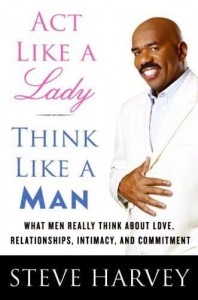 Most of the advice in Steve’s book has been already posted, in fact you can glean the major points just from reading the flap copy, so I won’t go into that.
Most of the advice in Steve’s book has been already posted, in fact you can glean the major points just from reading the flap copy, so I won’t go into that. 
